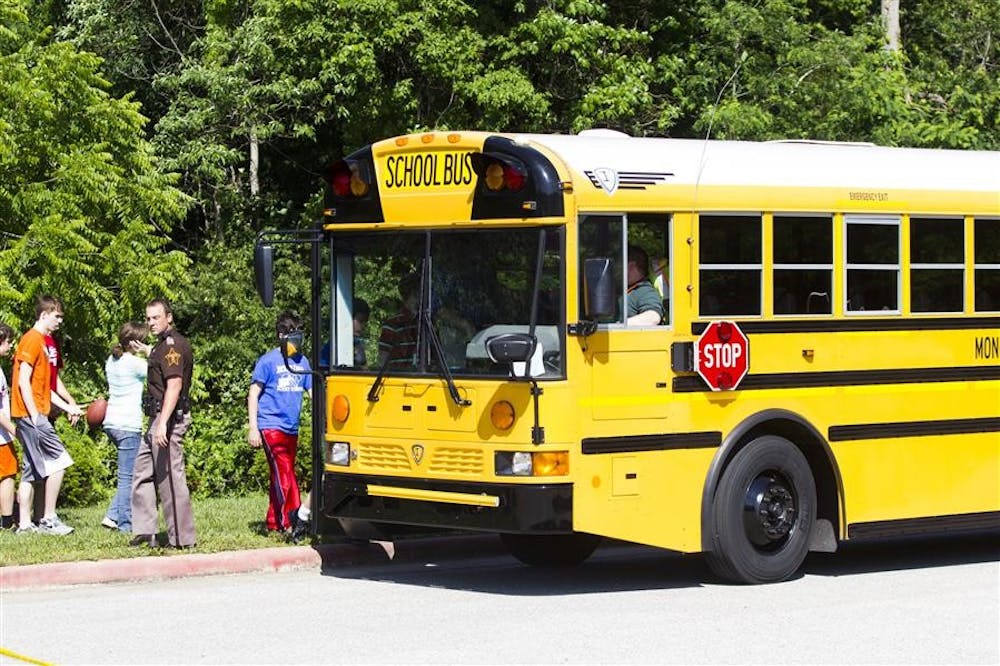Starter pistols fired blanks June 4 inside Jackson Creek Middle School as announcements came over the intercom to signal a school lockdown as part of a mass shooting drill.
Students and volunteers were ushered into classrooms by teachers and other officials where they were told to turn off the lights, lock the doors, and move to areas in the room where they would be less visible from the door.
As they waited for instructions from police officers to exit the building, first responders and police officers roamed the hallways, securing all the classrooms while tending to the “injured.”
Katie Cox, special education teacher and member of the Crisis Management Team at Jackson Creek Middle School, assisted in moving students and volunteers to the outside of the building where they would wait for transportation.
The active shooter training was funded by the Readiness and Emergency Management for Schools grant given to the Monroe County School Corporation.
Educators have very specialized roles during an active shooter event. This course reviews various active shooter incidents from schools throughout the country, the roles of school personnel, the duties of law enforcement, the RAIN acronym model for those with a “duty to protect’ and the ESCAPE model for those with no legal obligation, such as students and volunteers.
John Matthews, author of “Mass Shootings: Six Steps to Survival” and highly-decorated 30-year law enforcement veteran, was invited to lead and develop with first responders the proper plan to demonstrate the mass shooting scenario.
“The teachers have been trained in the RAIN model and students in the ESCAPE model,” he said. “We’ve practiced and now we are going to do all six steps.”
During the drill, student groups were placed in three different locations around Jackson Creek, two inside the building and one outside. Nadia Sabry, a seventh grader at Jackson Creek, was outside of the building with other students simulating gym class.
“We didn’t hear any gun shots or any announcements over the speaker,” Sabry said. “Other than police officers arriving, we wouldn’t have known anything was wrong.”
John Carter, director of planning for the MCCSC, said there were only a few errors during the drill, one being a failure of the outside speakers to broadcast the lockdown announcement and the other being a radio malfunction that kept him from notifying transportation.
After students exited the building on police officers’ command, buses were alerted to come and transport the students to Batchelor Middle School.
“Something that people don’t realize, when dealing with a school scenario, is what to do with students afterwards,” Cox said. “That’s as important as anything else, maintaining safety and security of the students in the chaos that can ensue after a shoot scenario like this.”
Once all the students and volunteers were transported to Batchelor, they began the unification process, where students reconnected with their parents or guardians. Three parents volunteered to be a part of this process.
Elizabeth Gately, Sabry’s mother, was one of them.
Gately said the parents were fully informed of what was going to happen with the drill so they knew what to expect. She also stated that some parents she talked to felt they could not participate in the drill because it was too emotional.
“I had a lot of friends say they could not do it because it would upset them too much,” Gately said. “But unfortunately it’s a reality these days and we have to deal with it. As parents, we do need to educate our children on what to do, not just at school, but at any public place like the theater, the mall or the grocery store. We need to ask them ‘what would you do if something like this happened?’ and schools are a great place to start the education.”
Upon arrival to Batchelor, students were placed in a safe area where no one could reach them until their parents arrived to pick them up. Once parents met with school officials, they had to fill out forms stating who their child was, what grade they were in, and what time the parent came to pick them up.
Also, parents had to present a form of identification to verify that they were the student’s guardian or relative.
Matthews instructed people that parents, grandparents, uncles and aunts would all show up to retrieve the students once they heard about the proposed shooting.
“If there are 500 kids in a school, 1,500 people will show up at the designated location to pick up their child. This is a three-to-one ratio,” Matthews said. “Administration is responsible for knowing the exact time that the child was picked up and who they were released to.”
He explained that a police officer would stand by to provide security because in high-pressure situations parents can become upset when their child isn’t immediately released to them.
The drill took roughly an hour to complete, from the start of the announcements until the reunification of the children with their parents.
After the drill, the students, first responders and MCCSC staff from around Monroe County met to discuss how the situation went.
Carter said everything seemed to go well, despite the two minor errors and that everything was well-scripted to ensure that the drill was a success.
Matthews explained that situations will always vary and that procedural changes can occur, but that’s not the important factor in these demonstrations.
“The more important thing is everybody learned something," he said. "It’s beneficial from my perspective that everything went as we planned it, but truly it’s invaluable to the school that they practice drills like these that can save lives.”
Shooting drill a success at Jackson Creek Middle School

Get stories like this in your inbox
Subscribe



